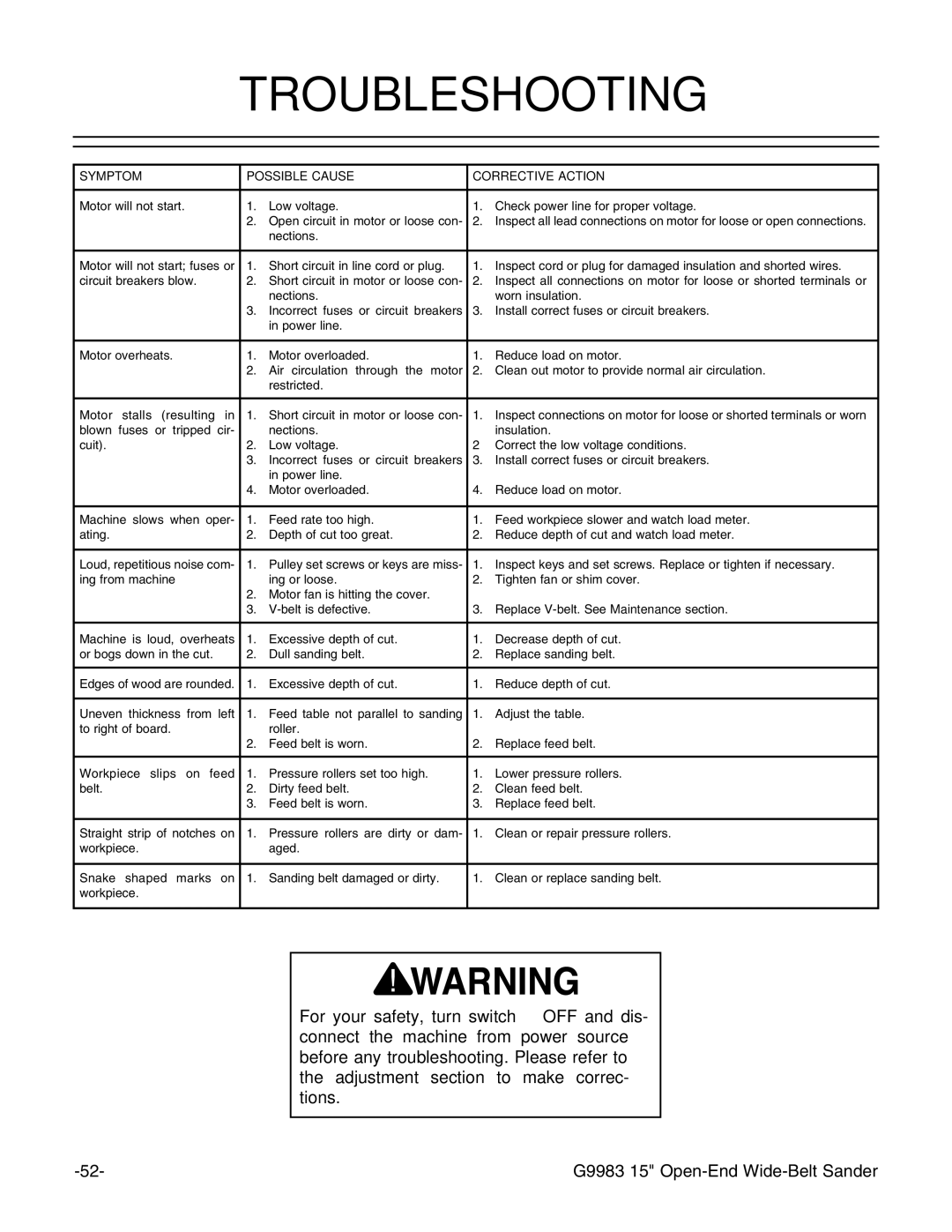
TROUBLESHOOTING
SYMPTOM |
|
| POSSIBLE CAUSE | CORRECTIVE ACTION | ||
|
|
|
|
|
|
|
Motor will not start. |
|
| 1. | Low voltage. | 1. | Check power line for proper voltage. |
|
|
| 2. | Open circuit in motor or loose con- | 2. | Inspect all lead connections on motor for loose or open connections. |
|
|
|
| nections. |
|
|
|
|
|
|
| ||
Motor will not start; fuses or | 1. | Short circuit in line cord or plug. | 1. | Inspect cord or plug for damaged insulation and shorted wires. | ||
circuit breakers blow. |
| 2. | Short circuit in motor or loose con- | 2. | Inspect all connections on motor for loose or shorted terminals or | |
|
|
|
| nections. |
| worn insulation. |
|
|
| 3. | Incorrect fuses or circuit breakers | 3. | Install correct fuses or circuit breakers. |
|
|
|
| in power line. |
|
|
|
|
|
|
|
|
|
Motor overheats. |
|
| 1. | Motor overloaded. | 1. | Reduce load on motor. |
|
|
| 2. | Air circulation through the motor | 2. | Clean out motor to provide normal air circulation. |
|
|
|
| restricted. |
|
|
|
|
|
|
|
| |
Motor stalls (resulting | in | 1. | Short circuit in motor or loose con- | 1. | Inspect connections on motor for loose or shorted terminals or worn | |
blown fuses or tripped cir- |
| nections. |
| insulation. | ||
cuit). |
|
| 2. | Low voltage. | 2 | Correct the low voltage conditions. |
|
|
| 3. | Incorrect fuses or circuit breakers | 3. | Install correct fuses or circuit breakers. |
|
|
|
| in power line. |
|
|
|
|
| 4. | Motor overloaded. | 4. | Reduce load on motor. |
|
|
|
|
| ||
Machine slows when oper- | 1. | Feed rate too high. | 1. | Feed workpiece slower and watch load meter. | ||
ating. |
|
| 2. | Depth of cut too great. | 2. | Reduce depth of cut and watch load meter. |
|
|
|
|
| ||
Loud, repetitious noise com- | 1. | Pulley set screws or keys are miss- | 1. | Inspect keys and set screws. Replace or tighten if necessary. | ||
ing from machine |
|
|
| ing or loose. | 2. | Tighten fan or shim cover. |
|
|
| 2. | Motor fan is hitting the cover. |
|
|
|
|
| 3. | 3. | Replace | |
|
|
|
|
| ||
Machine is loud, overheats | 1. | Excessive depth of cut. | 1. | Decrease depth of cut. | ||
or bogs down in the cut. |
| 2. | Dull sanding belt. | 2. | Replace sanding belt. | |
|
|
|
|
| ||
Edges of wood are rounded. | 1. | Excessive depth of cut. | 1. | Reduce depth of cut. | ||
|
|
|
|
|
|
|
Uneven thickness | from | left | 1. | Feed table not parallel to sanding | 1. | Adjust the table. |
to right of board. |
|
|
| roller. |
|
|
|
|
| 2. | Feed belt is worn. | 2. | Replace feed belt. |
|
|
|
|
|
| |
Workpiece slips | on feed | 1. | Pressure rollers set too high. | 1. | Lower pressure rollers. | |
belt. |
|
| 2. | Dirty feed belt. | 2. | Clean feed belt. |
|
|
| 3. | Feed belt is worn. | 3. | Replace feed belt. |
|
|
|
|
| ||
Straight strip of notches on | 1. | Pressure rollers are dirty or dam- | 1. | Clean or repair pressure rollers. | ||
workpiece. |
|
|
| aged. |
|
|
|
|
|
|
|
| |
Snake shaped marks | on | 1. | Sanding belt damaged or dirty. | 1. | Clean or replace sanding belt. | |
workpiece. |
|
|
|
|
|
|
|
|
|
|
|
|
|
For your safety, turn switch OFF and dis- connect the machine from power source before any troubleshooting. Please refer to the adjustment section to make correc- tions.
G9983 15" |
